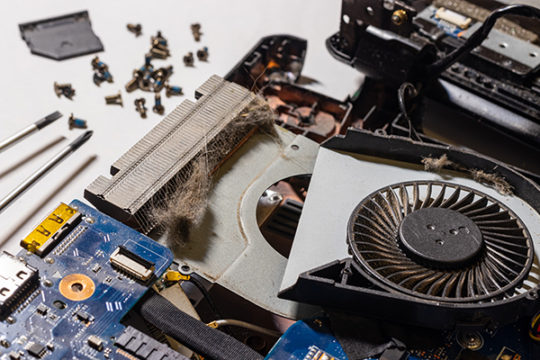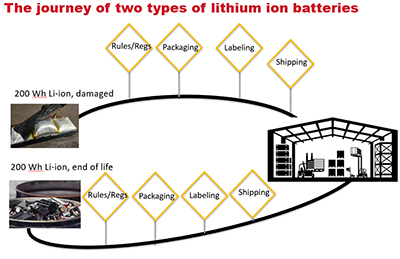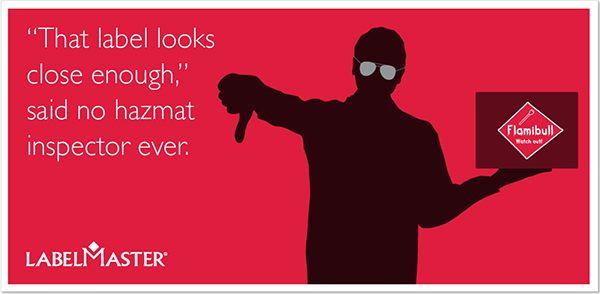
What happens to your laptop once you shut it down for the last time?
That’s a central question at the E-Scrap conference and Trade Show, the biggest event of the year for the electronics recycling industry. E-Scrap attendees and their companies are the folks who strip your old laptop of its reusable parts and raw materials while safely disposing of the rest.
They’re also the people who, more and more frequently, have to deal with the hazards of damaged, defective and recalled lithium batteries.
At last week’s conference in Orlando, recyclers from around the globe shared their questions and concerns with Labelmaster Senior Product Manager Bill Barger and Global Development Manager Thaddeus Puccini. Here’s a synopsis of what Barger and Puccini heard.
A thermal runaway event every week
Puccini says, “A common theme we heard from lots of recycling companies was a lack of awareness of the regulations and processes for dealing with damaged lithium batteries. They go to organizations, they could be from any industry, and they’re picking up anything they have—servers, keyboards, you name it—and throwing it in the container. But they’re not tuned into what a damaged battery looks like.”
The result? An increase in thermal runaway events. Puccini says, “ A gentleman from Israel told me he has a thermal runaway event every week and wanted to know what he could do about it.”
“The public doesn’t know anything about preventing these events,” adds Barger. “They leave devices plugged in all the time, and once they get rid of a device, they don’t really care what happens to it.”
Puccini says, “Until it affects them directly, it’s hard to get their attention.”
“Yes, you do have to sort them out.”
Different regulations don’t automatically make life more difficult, however. Barger says, “If you have a swollen battery or one that looks at all out of normal, use Obexion Max packaging. It’s safe, it’s fire-retardant, you’re in compliance—you’re done. No one wants to get that phone call—hey, we had a fire, we had an explosion—so standard order of procedure, if it’s out of normal, put it in this box.”

Participating in the panel discussion on the future of batteries, Puccini walked everyone through the processes of shipping batteries to recyclers. “I explained that damaged and intact batteries are governed by a completely different set of regulations so, yes, you do have to sort them out.”
He adds, ”We had a lot of conversations with recyclers who didn’t realize they could also have an Obexion Vault unit to safely contain batteries that are already in thermal runaway.”
A subtle difference between compliant and realistic
Barger and Puccini met recyclers from Europe, South America and elsewhere, and fielded numerous questions along the lines of “How do I ship damaged batteries from Germany to the U.S.” (Short answer: you don’t.)
A question about ocean shipping illustrated the subtle difference between what’s compliant and what’s realistic.
“You can compliantly ship end-of-life or damaged lithium batteries by vessel, but vessel companies don’t have to take them,” explains Puccini. “There’s no hard definition of ‘damage,’ so they’re hard to classify. When a carrier hears about six pallets of used batteries, they hear ‘hazardous waste.’ Plus, there’s a U.K. insurance group that says if a vessel accepts damaged batteries, they must be at zero percent state-of-charge.”

“Which is hard to prove,” adds Barger, “and actually makes them more dangerous.”
The main takeaway they both shared with recyclers at the E-Scrap conference was summed up by Puccini:
“Dangerous Goods rules and regulations are 99 percent of my life. Come see me for the solutions you need. You don’t cut your own hair. Why try to reinvent the wheel when it comes to shipping lithium batteries?”
Make sure your shipments are safe and in complete compliance with a full line of solutions from Labelmaster—a full-service provider of goods and services for hazardous materials and Dangerous Goods professionals, shippers, transport operators and EH&S providers.


